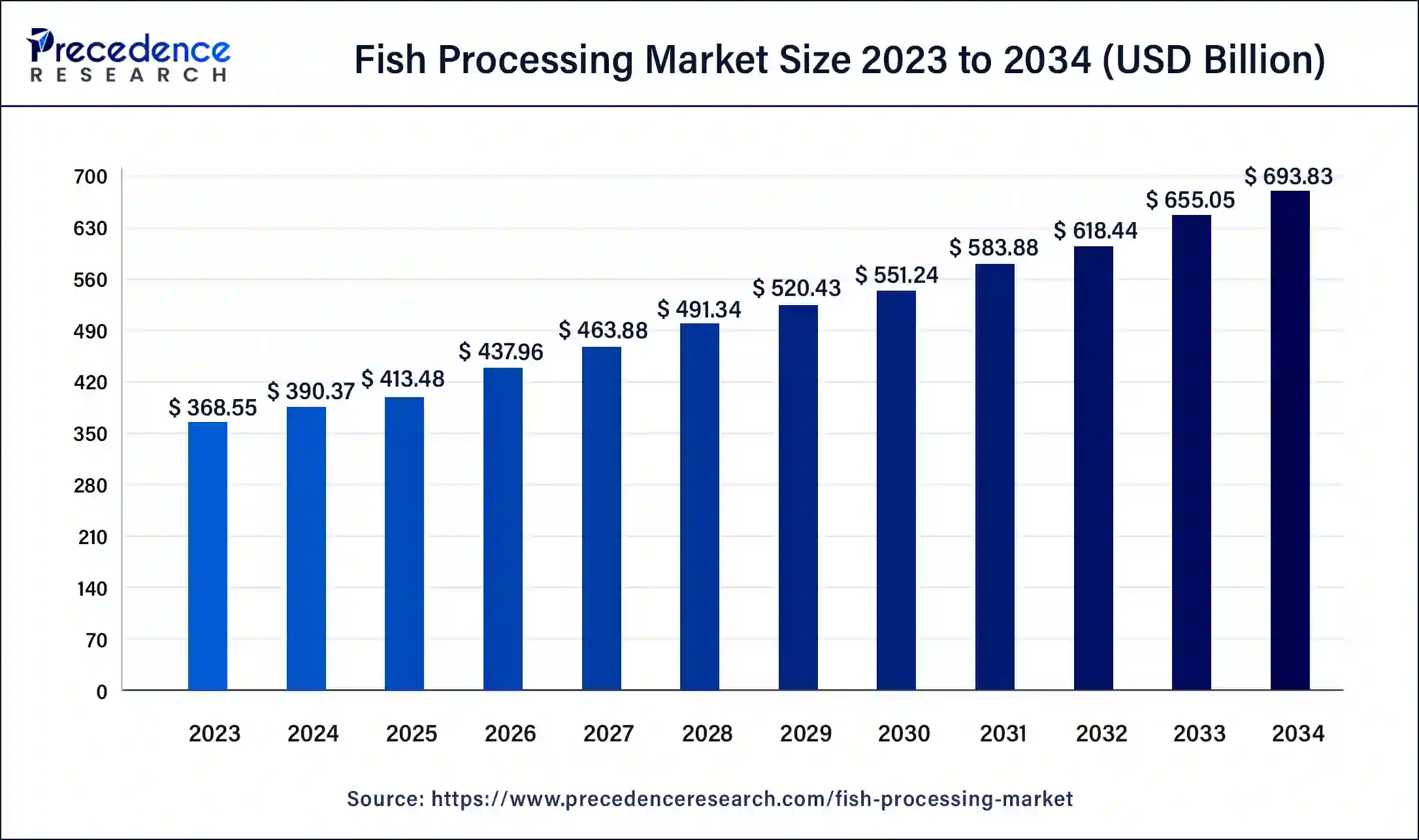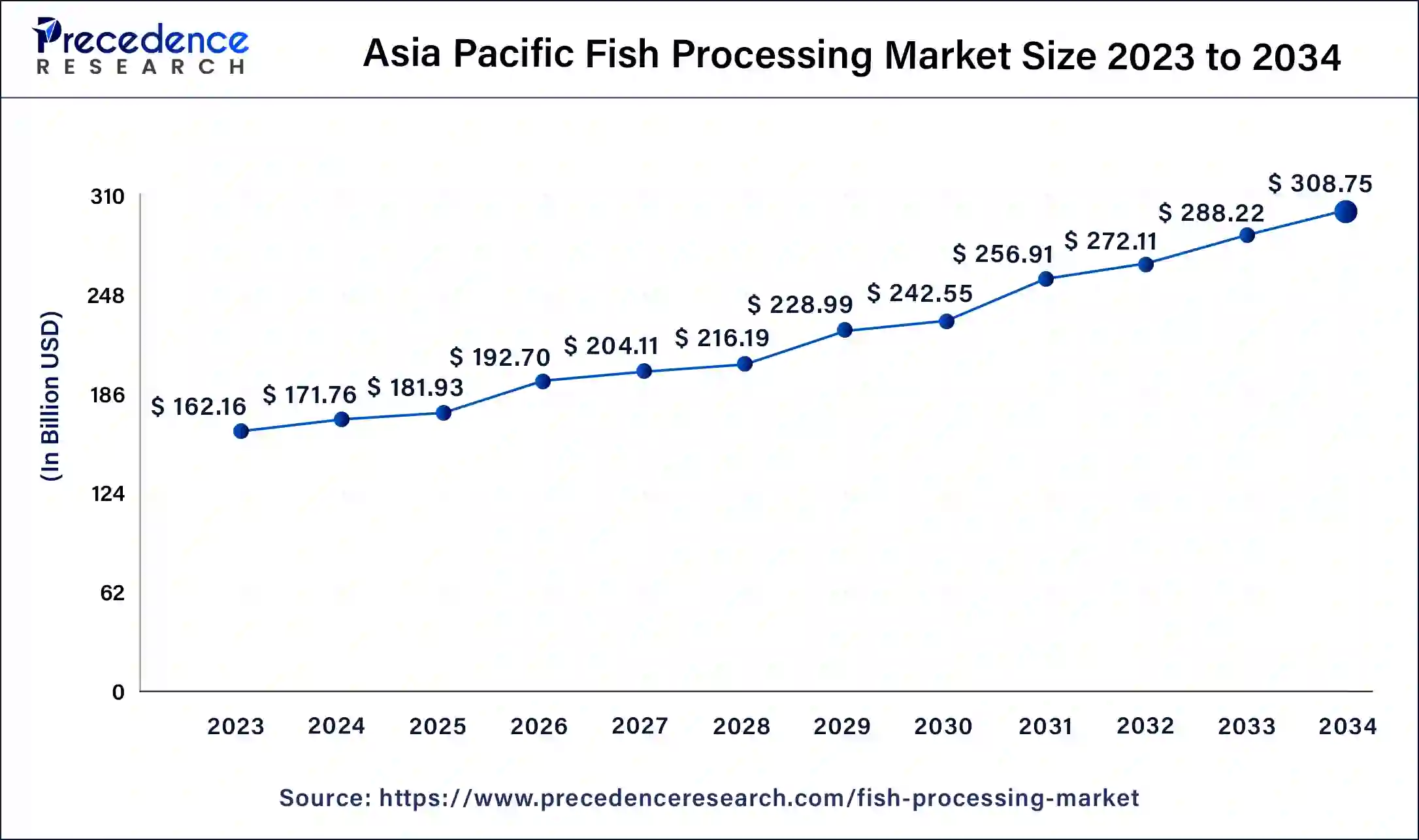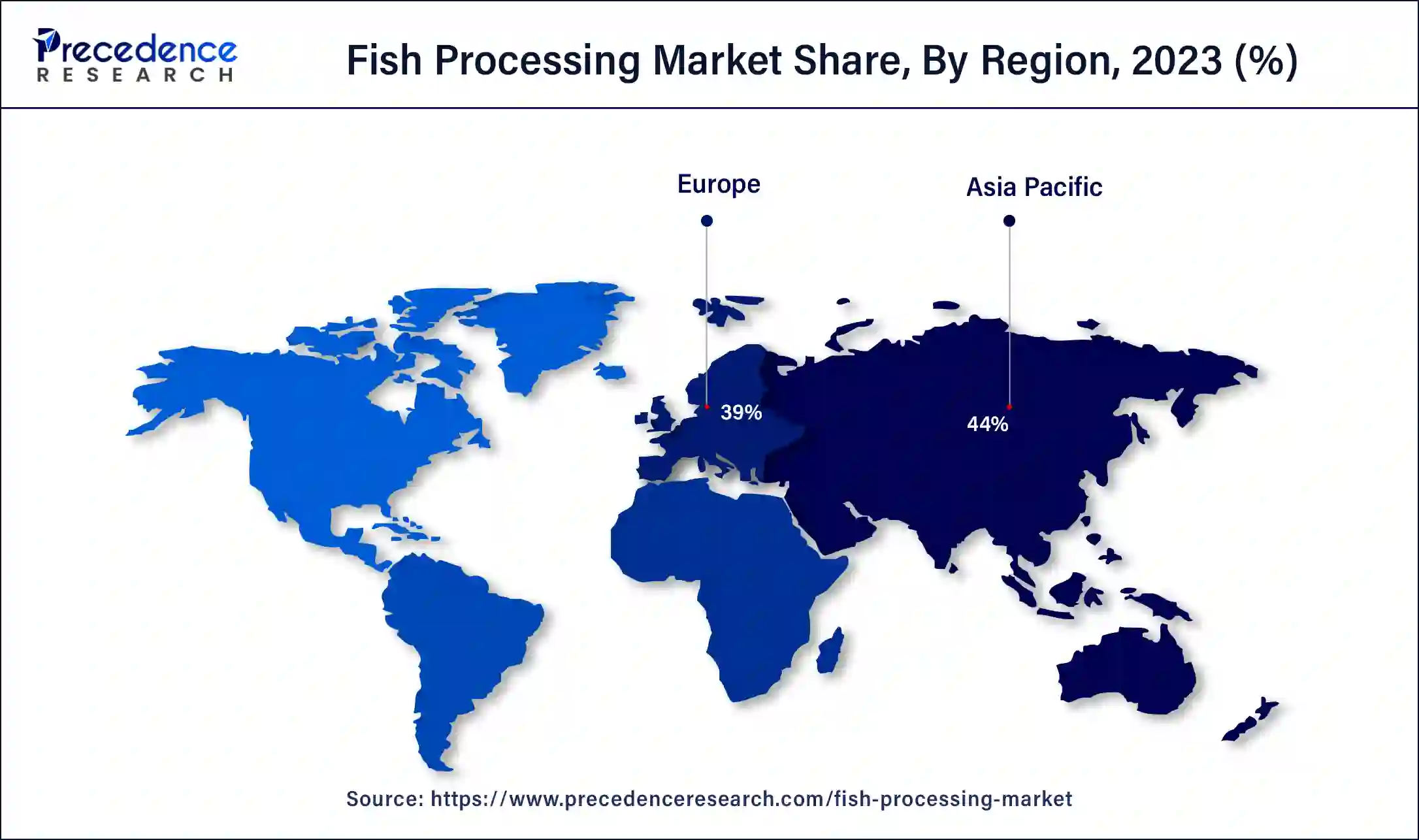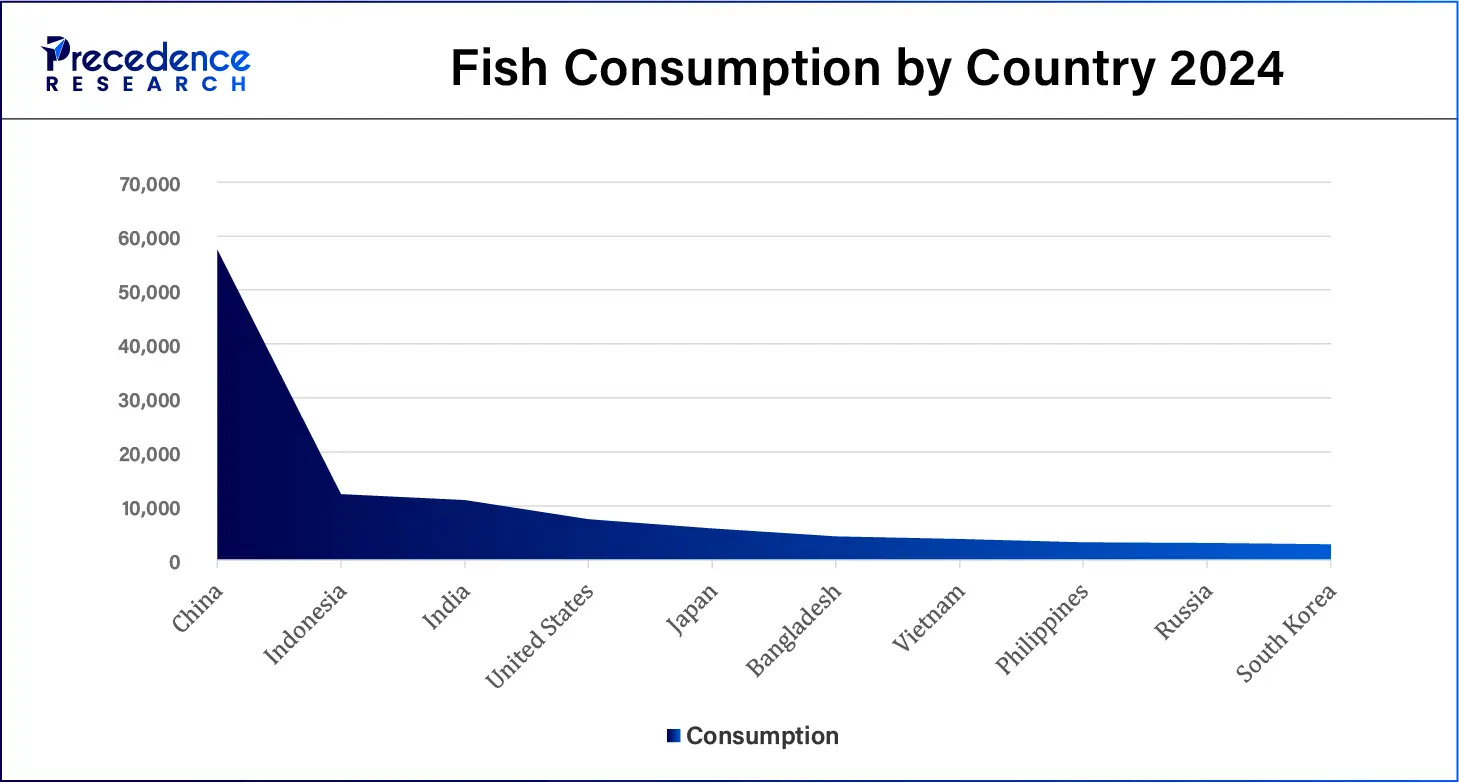August 2024
The global fish processing market size was USD 368.55 billion in 2023, calculated at USD 390.37 billion in 2024 and is expected to be worth around USD 693.83 billion by 2034. The market is slated to expand at 5.92% CAGR from 2024 to 2034.
The global fish processing market size is worth around USD 390.37 billion in 2024 and is anticipated to reach around USD 693.83 billion by 2034, growing at a solid CAGR of 5.92% over the forecast period 2024 to 2034.

The Asia Pacific fish processing market size was exhibited at USD 162.16 billion in 2023 and is projected to be worth around USD 308.75 billion by 2034, poised to grow at a CAGR of 6.02% from 2024 to 2034.

Asia Pacific contributed the largest share of the fish processing market in 2023. The increasing demand for food and nutritional security in rural, coastal, and urban populations is boosting the market in the region. Across Asia Pacific, fishery products play an important role in human well-being, food security, and poverty alleviation. The top consumer countries are China, Japan, Myanmar, and Vietnam.


North America is anticipated to grow at the fastest rate in the fish processing market during the forecast period. The increasing aquaculture production is fueling the fish processing market in North America. It consists of bivalve mollusks such as clams, mussels, and oysters. Salmon and shrimp add to the market. However, advances in aquaculture feeds, management techniques, and technology are enabling Americans to consume more species. Canada and the United States have strong institutional support for aquaculture and government commitments to expand the industry.
Fish processing involves the preparation of fish products through chemical or mechanical techniques for transformation and preservation. There are several ways of processing a fish, such as freezing, drying, smoking, irradiation, and many more. The fish processing market operations maintain the quality of eating and preserve the food for a longer time. Nutrition, health, and convenience are major factors in expanding the fish processing industry. The fish and seafood industry ranks third among the food categories worldwide. Oily fish such as salmon, sardines, and tuna contain high amounts of omega-3 fatty acids, which support the brain, nerve development, and eyes.
How is AL changing the Fish Processing Market?
Artificial intelligence has become increasingly demanding in the fish processing market for research and production. AI is applied in both startups and established companies. AI technology has developed the easy adaptation of fish production. Convolutional neural networks are deep learning algorithms that are especially useful for image recognition and interpretation. Deep learning goes beyond layering algorithms, self-evaluation, and adjustment. The system of deep learning learns through its computing processes.
Deep learning and convolutional neural network advancement make a major impact on the fish processing market. Sensor technology and connectivity options such as the Cloud, 5G networks, and the Internet of Things (IoT) have made an advancement in the field. With the help of AI, aquaculture has been noticed to improve feeding efficiency, growth tracking, biomass estimation, early detection of diseases, environmental monitoring and control (especially in RAS), and reduction of labor costs.
| Report Coverage | Details |
| Market Size by 2034 | USD 693.83 Billion |
| Market Size in 2024 | USD 390.37 Billion |
| Market Growth Rate from 2024 to 2034 | CAGR of 5.92% |
| Largest Market | Asia Pacific |
| Base Year | 2023 |
| Forecast Period | 2024 to 2034 |
| Segments Covered | Type, Species, Application, and Regions |
| Regions Covered | North America, Europe, Asia-Pacific, Latin America and Middle East & Africa |
Health benefits
Fish products consist of high amounts of important nutritional components such as high-quality protein, minerals, essential vitamins, and healthy polyunsaturated fatty acids in the human diet. Fish provides omega-3 fatty acids, which reduce the risk of developing irregular heartbeats (arrhythmias). The American Heart Association recommends including fish in meals twice a week for a healthy diet. The presence of essential amino acids in fish improves the dietary protein intake, making a positive impact on the fish processing market. Recent research states that fish is a great alternative to the source of animal protein. Fish oil helps in brain development in unborn babies and infants, contributing to improving visual acuity, memory, motor, and cognitive development tests.
Quality problem
The fish and seafood have the property to perish quickly, impacting the growth of the fish processing market. Improper harvesting, inadequate handling, processing, and storage lead to quality problems. The quality must be maintained throughout the stages and till it is delivered to the consumer. The main reasons for quality problems to arise are poor quality of raw materials, microbiological contamination, ice and water, and the presence of heavy metals and storage. With the demand for high-quality fish and seafood and due to Modified Inplant Quality Control (MIPQC), the circumstances are better in the export market. Still, the freshness and quality control are worse in the domestic market.
To seek improvement in the fish processing market, it is essential to provide quality awareness, training, and demonstration among fishermen and fish handlers. Moreover, infrastructural facilities like ice making while onboarding and shoring, cold storage facilities, and refrigerated transportation are needed. For instance, a study from FAO explains how due to the poor quality of infrastructural facilities in the field of fish harvesting, landing, handling, preservation, distribution, marketing, and quality assurance is affecting the foreign exchange market in Bangladesh and how necessary it is to implement HACCP systems.
Improvement and advances
The only major factor lacking in the fish processing market is the maintenance of quality and that is expected to be improved in the coming years. The traditional safety and quality monitoring technique is quite time-consuming and is lacking in well-trained operators. Therefore, there is a need to develop a reliable and sensitive product to monitor the safety and quality of aquatic produce.
Biosensors facilitate the improvement in the fish processing market by detecting contamination such as metal ions, gases, biomolecules, gases, foodborne microorganisms, and organic molecules. The process that takes about a week to identify foodborne pathogens can be detected within a few hours with the help of a biosensor.
The frozen segment accounted for the biggest share of the fish processing market in 2023. The frozen fish processing technique is used to retain the quality and freshness of the fish. The initial step is to convert the water content in the fish to ice. This process takes about 3-72 hours at -15°C to -29°C for slow freezing, and quick freezing takes only 30 min to 1 hour at -40°C. This process delays microbial growth and enzyme action by eliminating the availability of water. The commonly adopted freezing techniques by the processing industry are plate freezing, air blast freezing, cryogenic freezing, and individual quick freezing. Freezing a fish does not reduce its nutritional value, and it is perfectly healthy and does not contain any additional ingredients.
The preserved segment is expected to witness significant growth in the fish processing market during the forecast period. There are various preservative methods, such as freezing, sun drying, salt drying, canning, smoking, or pickling; each technique has its attributes and benefits. The contribution of each method is different; some stop the growth of spoilage microorganisms, some remove the moisture content, and some add desired flavors and aromas to the fish. The choice of the required pervasive methods depends on the producer's type of fish, available resources, and desired flavor profiles.
The fish segment held a dominant presence in the fish processing market in 2023. A fish has a great combination of high-quality protein and major vital nutrients. The consumer demand to eat a healthy diet drives the market. The consumption of fish lowers the risk of heart attack and stroke. In a study conducted in the United States, more than 40,000 men regularly ate one or more servings of fish per week, resulting in a 15% lower risk of heart disease. Researchers believe that fatty fish are even more beneficial for heart health due to the presence of omega-3.
The crustacean segment will witness considerable growth in the fish processing market over the forecast period. Crustaceans are the second largest food product in aquaculture, followed by fish. The global increase in consumption of crustaceans is witnessed. The reason for the growth is high nutrients such as protein, amino acids, carbohydrates, minerals, and vitamins. It also has a small amount of omega-3 compared to fish. For instance, prawns have 300-400 mg per 100 grams, and salmon has 2.6 grams of omega-3 in 100 grams. Consumers are becoming aware of the health benefits of crustaceans, which also contribute to the aquaculture industry. Crustaceans help to lose weight, promote brain and heart health, and boost immunity.
The food segment registered its dominance over the global fish processing market in 2023. The rising demand for variations in culinary dishes is fueling the fish processing market. The extensive consumption of processed raw fish such as Sashimi, Sushi, Ceviche, and Gravlaks provides options for diverse dishes. The perspective of society towards raw fresh fish is healthy, luxurious, and upper-class. The diversity of processed fish increases consumers' attraction towards it. The existence of fish processing creates economic value and trends in society. Consuming raw fish can lead to a health process as it is not cooked due to the presence of parasites. Fishes that are consumed raw are salmon, cod, tuna, and sardines. Fishes like tuna are used for sashimi, and sushi is parasite-resistant; therefore, they are safe to consume raw. Moreover, the expanded seafood food industry has various culinary options.
The other commercial use segment is projected to expand rapidly in the fish processing market in the coming years. Commercial fish and seafood are consumed at home, in restaurants, and in food services. The sources of these seafood are commercial fisheries and aquaculture production, and they are imported from other countries. A few of the products are ready-to-eat, such as seafood salads, entrees, or other items. There are a variety of fish products available on the market, such as fresh fish fillets or steaks, frozen products, breaded fish portions, or canned or smoked fish. Distributors and wholesalers receive raw and processed products from a wide variety of domestic and foreign sources and distribute them to restaurants and retail stores.
Segments Covered in the Report
By Type
By Species
By Application
By Geography
For inquiries regarding discounts, bulk purchases, or customization requests, please contact us at sales@precedenceresearch.com
No cookie-cutter, only authentic analysis – take the 1st step to become a Precedence Research client
August 2024
January 2025
August 2024
November 2024